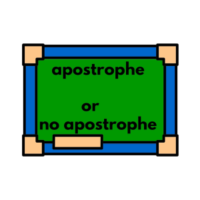Grammar Tidbits: Showing Possession with Words Ending in ‘S’
If a word already ends in an s, do you add another s to make it possessive? Or can you simply add an apostrophe?
Let’s look into the case of plural possessives today.
To start, know that you want to use an apostrophe to show that a thing or person belongs to or relates to someone or something.
For plural words that end in an s, add an apostrophe to show possession:
- Boys’ bunkhouse (singular possessive: one boy’s bunk)
- Girls’ school (singular possessive: a girl’s school)
- Ferrets’ anctics (singular possessive: the ferret’s anctics)
- Storms’ behaviors (singular possessive: the storm’s behavior)
- Four-days’ journey (singular possessive: one-day’s journey)
- Horses’ stable (singular possessive: a horse’s stall)
- Countries’ laws (singular possessive: a country’s laws)
(Plural words that don’t end in s require the apostrophe s (‘s) to show possession: children’s, oxen’s, men’s, women’s, deer’s, mice’s, geese’s, and so on.)
*Proper names ending in s use the apostrophe s when you’d say/hear the extra ‘s’ in speech:
- Thomas’s sister
- James’s coat
- Phyllis’s presentation
- Charles’s truck
- Dickens’s novels
- Travis’s adventure
*Proper names ending in s use only the apostrophe when the extra s is not spoken:
- Mr. Bridges’ complaint
- Connors’ rendition
- Socrates’ philosophy
- Ulysses’ companions
Singular nouns that end in s, need the apostrophe s:
- Boss’s anniversary
- Bus’s axle
- Witness’s account
*Note that style guides differ on whether to use an apostrophe s or only the apostrophe in regard to proper names that end in s. So if you’re working for a client that uses Chicago Manual of Style (add ’s), Associated Press Style Book (add ’), New York Times (’s or ’), or another style guide, check to see which format is used.

